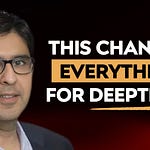In a recent episode of The Ignite Podcast, host Brian Bell sat down with Kevin Carter, the founder and CIO of EMQQ Global, to explore the rapidly evolving landscape of emerging market investing. Kevin shared insights from his journey in finance, his experience launching innovative ETFs, and his strong conviction that traditional emerging market indices are flawed. He also dove deep into India’s digital transformation and why it presents one of the most exciting investment opportunities today.
If you don’t have time to listen to the full episode, this blog post breaks down the key takeaways from their conversation.
How Kevin Carter Became a Pioneer in Emerging Market Investing
Kevin Carter’s path into investing wasn’t conventional. After earning an economics degree, he landed a job at Robertson Stephens, a premier technology investment bank, despite having no background in finance. His first assignment? Read A Random Walk Down Wall Street by Dr. Burton Malkiel, a book that would go on to shape his investing philosophy.
Kevin’s career started in active mutual funds, but over time, he became disillusioned with the industry’s high fees and inefficiencies. He realized that traditional mutual funds weren’t structured in a way that truly benefited investors, which led him to explore index investing—an approach that prioritizes broad, low-cost exposure to the market.
After working with legendary investors like Warren Buffett and Peter Lynch, Kevin saw the shortcomings of traditional emerging market ETFs. Most of these funds were dominated by state-owned enterprises (SOEs)—banks and oil companies with little incentive to grow earnings. This realization led him to found EMQQ, an ETF focused on internet and e-commerce companies in emerging markets, which he believed better captured the true growth potential of these economies.
Why Traditional Emerging Market Indexes Are Flawed
One of the biggest challenges in emerging markets is what’s actually inside most ETFs. Kevin pointed out that traditional emerging market funds, such as those tracking the MSCI Emerging Markets Index, are often heavily weighted toward state-owned enterprises—companies that operate under government control and don’t always prioritize profitability or shareholder value.
For example, in China, many of the top holdings in these funds are government-controlled banks and oil companies, which are often inefficient and even corrupt. Meanwhile, the real growth drivers of emerging markets—e-commerce, fintech, and mobile technology—are underrepresented or excluded from these indices.
That’s why Kevin launched EMQQ, an ETF designed to give investors exposure to the internet economy in emerging markets. Companies like Mercado Libre (Latin America’s Amazon), Alibaba, and Tencent represent the future of these economies, as they benefit from rising digital adoption, increasing disposable income, and rapid smartphone penetration.
India’s Digital Revolution: The Investment Opportunity of the Decade
While China has dominated the conversation around emerging markets for years, India is now in the spotlight as one of the most compelling investment opportunities. Kevin described India’s rapid digital transformation, fueled by a groundbreaking innovation called the India Stack—a nationwide digital identity and payments infrastructure that is reshaping the country’s economy.
Here’s why India is set to be the biggest emerging market success story over the next two decades:
Massive Population Growth: India recently surpassed China as the world’s most populous country, and every day sets a new record for the largest population in history.
Young Demographics: With an average age of 28, India has one of the youngest workforces in the world, unlike China, which is now facing a demographic decline.
Digital Identity & Banking Revolution: The India Stack has brought 800 million people into the financial system, giving them access to digital banking and payments for the first time.
Explosion of Startups: Seven years ago, India had only 500 startups—today, there are over 120,000, driven by entrepreneurs leveraging the country’s digital infrastructure.
Kevin believes that India presents an unprecedented opportunity for investors, as the country accelerates digital adoption and embraces e-commerce, fintech, and mobile payments.
The Rise of Quick Commerce in Emerging Markets
One of the most exciting trends Kevin discussed is quick commerce—the rapid delivery of products within minutes of ordering. In India, companies like Blinkit and Zepto are pioneering this model, using dense city layouts, micro-warehouses, and two-wheeled delivery networks to fulfill orders faster than ever before.
This model has already taken off in China and Latin America, and Kevin sees India as the next major market for this transformation. With cheap mobile data, a growing middle class, and digital payments adoption, the demand for instant delivery services is skyrocketing.
Investors looking at e-commerce and logistics startups in India are well-positioned to benefit from this next wave of digital growth.
How Venture Investors Should Approach Emerging Markets
Brian and Kevin wrapped up the conversation by discussing how venture capitalists can best navigate emerging markets. Here are some key takeaways:
Be on the Ground – Investing remotely isn’t enough. Understanding local markets and regulations is crucial to making informed decisions.
Focus on Technology & E-Commerce – Digital-first businesses are scaling faster than traditional industries and have higher margins.
Find the Right Partners – Many successful investors partner with local funds and accelerators who have on-the-ground expertise.
Think Long-Term – Investing in emerging markets isn’t about short-term gains. It’s about backing the companies that will drive economic growth for the next two decades.
Final Thoughts: The Next Two Decades Belong to India
Kevin Carter has spent years studying how digital transformation fuels economic growth in emerging markets. His key insight? India is at an inflection point, and investors who position themselves correctly today stand to benefit tremendously over the next 10-20 years.
With a young population, a rapidly growing digital economy, and government-led innovation through the India Stack, the country is poised to become the dominant emerging market of the 21st century.
For investors looking to gain exposure to this massive economic shift, Kevin recommends avoiding traditional emerging market indices and instead focusing on tech-driven opportunities like those in EMQQ and INQQ, which capture the true drivers of growth in these economies.
👂🎧 Watch, listen, and follow on your favorite platform: https://tr.ee/S2ayrbx_fL
🙏 Join the conversation on your favorite social network: https://linktr.ee/theignitepodcast
Chapters:
Welcome & Guest Introduction (00:00 – 00:38)
Kevin’s Unlikely Entry into Finance (00:39 – 02:15)
The Impact of A Random Walk Down Wall Street (02:16 – 04:25)
Early Mutual Fund Industry Lessons (04:26 – 07:42)
From Active Investing to Indexing (07:43 – 10:15)
The Origins of e-Investing & Fractional Shares (10:16 – 14:55)
Dot-Com Era, Shorting Amazon, & Meeting Burt Malkiel (14:56 – 18:28)
Startup Lessons & Selling to E-Trade (18:29 – 20:10)
India Focus & Investing Post E-Trade Exit (20:11 – 22:25)
The Birth of Active Indexing (22:26 – 24:42)
Direct Indexing Advantages: Customization & Tax Efficiency (24:43 – 27:00)
Google IPO, Private Clients, & India Exposure (27:01 – 31:01)
Why Traditional Emerging Market ETFs Are Flawed (31:02 – 36:27)
The Case for Consumer-Focused Emerging Markets Investing (36:28 – 38:41)
Launching EMQQ and the Power of the Internet in EMs (38:42 – 41:34)
Three Megatrends Converging in Emerging Markets (41:35 – 44:47)
India vs. China – A Digital Leapfrog (44:48 – 48:05)
How VCs Should Think About India (48:06 – 51:09)
Zepto, Private vs Public Markets, and Unicorn Growth (51:10 – 54:02)
Why INQQ and India’s Digital Opportunity (54:03 – 56:53)
The India Stack: Infrastructure for Digital Dominance (56:54 – 01:02:48)
How the India Stack Powers UPI & Fintech Explosion (01:02:49 – 01:06:30)
Entrepreneurship, Startups & Talent in India (01:06:31 – 01:08:09)
Quick Commerce in India & Final Thoughts (01:08:10 – 01:09:38)










